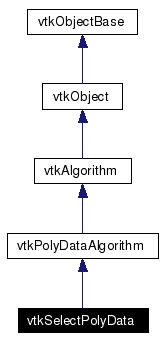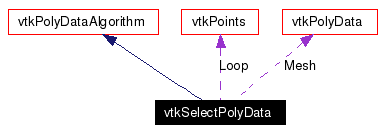vtkSelectPolyData Class Reference
#include <vtkSelectPolyData.h>
Inheritance diagram for vtkSelectPolyData:
 [legend]Collaboration diagram for vtkSelectPolyData:
[legend]Collaboration diagram for vtkSelectPolyData: [legend]List of all members.
[legend]List of all members.
Detailed Description
select portion of polygonal mesh; generate selection scalars
vtkSelectPolyData is a filter that selects polygonal data based on defining a "loop" and indicating the region inside of the loop. The mesh within the loop consists of complete cells (the cells are not cut). Alternatively, this filter can be used to generate scalars. These scalar values, which are a distance measure to the loop, can be used to clip, contour. or extract data (i.e., anything that an implicit function can do).
The loop is defined by an array of x-y-z point coordinates. (Coordinates should be in the same coordinate space as the input polygonal data.) The loop can be concave and non-planar, but not self-intersecting. The input to the filter is a polygonal mesh (only surface primitives such as triangle strips and polygons); the output is either a) a portion of the original mesh laying within the selection loop (GenerateSelectionScalarsOff); or b) the same polygonal mesh with the addition of scalar values (GenerateSelectionScalarsOn).
The algorithm works as follows. For each point coordinate in the loop, the closest point in the mesh is found. The result is a loop of closest point ids from the mesh. Then, the edges in the mesh connecting the closest points (and laying along the lines forming the loop) are found. A greedy edge tracking procedure is used as follows. At the current point, the mesh edge oriented in the direction of and whose end point is closest to the line is chosen. The edge is followed to the new end point, and the procedure is repeated. This process continues until the entire loop has been created.
To determine what portion of the mesh is inside and outside of the loop, three options are possible. 1) the smallest connected region, 2) the largest connected region, and 3) the connected region closest to a user specified point. (Set the ivar SelectionMode.)
Once the loop is computed as above, the GenerateSelectionScalars controls the output of the filter. If on, then scalar values are generated based on distance to the loop lines. Otherwise, the cells laying inside the selection loop are output. By default, the mesh lying within the loop is output; however, if InsideOut is on, then the portion of the mesh lying outside of the loop is output.
The filter can be configured to generate the unselected portions of the mesh as output by setting GenerateUnselectedOutput. Use the method GetUnselectedOutput to access this output. (Note: this flag is pertinent only when GenerateSelectionScalars is off.)
- Warning:
- Make sure that the points you pick are on a connected surface. If not, then the filter will generate an empty or partial result. Also, self-intersecting loops will generate unpredictable results.
During processing of the data, non-triangular cells are converted to triangles if GenerateSelectionScalars is off.
- See also:
- vtkImplicitSelectionLoop
- Tests:
- vtkSelectPolyData (Tests)
Definition at line 93 of file vtkSelectPolyData.h.
Member Typedef Documentation
Constructor & Destructor Documentation
| vtkSelectPolyData::vtkSelectPolyData |
( |
|
) |
[protected] |
|
| vtkSelectPolyData::~vtkSelectPolyData |
( |
|
) |
[protected] |
|
Member Function Documentation
|
|
Instantiate object with InsideOut turned off, and GenerateSelectionScalars turned off. The unselected output is not generated, and the inside mode is the smallest region.
Reimplemented from vtkPolyDataAlgorithm. |
| virtual const char* vtkSelectPolyData::GetClassName |
( |
|
) |
[virtual] |
|
| static int vtkSelectPolyData::IsTypeOf |
( |
const char * |
type |
) |
[static] |
|
|
|
Return 1 if this class type is the same type of (or a subclass of) the named class. Returns 0 otherwise. This method works in combination with vtkTypeRevisionMacro found in vtkSetGet.h.
Reimplemented from vtkPolyDataAlgorithm. |
| virtual int vtkSelectPolyData::IsA |
( |
const char * |
type |
) |
[virtual] |
|
|
|
Return 1 if this class is the same type of (or a subclass of) the named class. Returns 0 otherwise. This method works in combination with vtkTypeRevisionMacro found in vtkSetGet.h.
Reimplemented from vtkPolyDataAlgorithm. |
| void vtkSelectPolyData::PrintSelf |
( |
ostream & |
os, |
|
|
vtkIndent |
indent |
|
) |
[virtual] |
|
|
|
Methods invoked by print to print information about the object including superclasses. Typically not called by the user (use Print() instead) but used in the hierarchical print process to combine the output of several classes.
Reimplemented from vtkPolyDataAlgorithm. |
| virtual void vtkSelectPolyData::SetGenerateSelectionScalars |
( |
int |
|
) |
[virtual] |
|
|
|
Set/Get the flag to control behavior of the filter. If GenerateSelectionScalars is on, then the output of the filter is the same as the input, except that scalars are generated. If off, the filter outputs the cells laying inside the loop, and does not generate scalars. |
| virtual int vtkSelectPolyData::GetGenerateSelectionScalars |
( |
|
) |
[virtual] |
|
| virtual void vtkSelectPolyData::GenerateSelectionScalarsOn |
( |
|
) |
[virtual] |
|
| virtual void vtkSelectPolyData::GenerateSelectionScalarsOff |
( |
|
) |
[virtual] |
|
| virtual void vtkSelectPolyData::SetInsideOut |
( |
int |
|
) |
[virtual] |
|
|
|
Set/Get the InsideOut flag. When off, the mesh within the loop is extracted. When on, the mesh outside the loop is extracted. |
| virtual int vtkSelectPolyData::GetInsideOut |
( |
|
) |
[virtual] |
|
|
|
Set/Get the InsideOut flag. When off, the mesh within the loop is extracted. When on, the mesh outside the loop is extracted. |
| virtual void vtkSelectPolyData::InsideOutOn |
( |
|
) |
[virtual] |
|
|
|
Set/Get the InsideOut flag. When off, the mesh within the loop is extracted. When on, the mesh outside the loop is extracted. |
| virtual void vtkSelectPolyData::InsideOutOff |
( |
|
) |
[virtual] |
|
|
|
Set/Get the InsideOut flag. When off, the mesh within the loop is extracted. When on, the mesh outside the loop is extracted. |
| virtual void vtkSelectPolyData::SetLoop |
( |
vtkPoints * |
|
) |
[virtual] |
|
|
|
Set/Get the array of point coordinates defining the loop. There must be at least three points used to define a loop. |
| virtual vtkPoints* vtkSelectPolyData::GetLoop |
( |
|
) |
[virtual] |
|
|
|
Set/Get the array of point coordinates defining the loop. There must be at least three points used to define a loop. |
| virtual void vtkSelectPolyData::SetSelectionMode |
( |
int |
|
) |
[virtual] |
|
|
|
Control how inside/outside of loop is defined. |
| virtual int vtkSelectPolyData::GetSelectionMode |
( |
|
) |
[virtual] |
|
|
|
Control how inside/outside of loop is defined. |
| void vtkSelectPolyData::SetSelectionModeToSmallestRegion |
( |
|
) |
[inline] |
|
| void vtkSelectPolyData::SetSelectionModeToLargestRegion |
( |
|
) |
[inline] |
|
| void vtkSelectPolyData::SetSelectionModeToClosestPointRegion |
( |
|
) |
[inline] |
|
| const char * vtkSelectPolyData::GetSelectionModeAsString |
( |
void |
|
) |
[inline] |
|
| virtual void vtkSelectPolyData::SetGenerateUnselectedOutput |
( |
int |
|
) |
[virtual] |
|
|
|
Control whether a second output is generated. The second output contains the polygonal data that's not been selected. |
| virtual int vtkSelectPolyData::GetGenerateUnselectedOutput |
( |
|
) |
[virtual] |
|
|
|
Control whether a second output is generated. The second output contains the polygonal data that's not been selected. |
| virtual void vtkSelectPolyData::GenerateUnselectedOutputOn |
( |
|
) |
[virtual] |
|
|
|
Control whether a second output is generated. The second output contains the polygonal data that's not been selected. |
| virtual void vtkSelectPolyData::GenerateUnselectedOutputOff |
( |
|
) |
[virtual] |
|
|
|
Control whether a second output is generated. The second output contains the polygonal data that's not been selected. |
| vtkPolyData* vtkSelectPolyData::GetUnselectedOutput |
( |
|
) |
|
|
|
|
Return output that hasn't been selected (if GenreateUnselectedOutput is enabled). |
|
|
Return the (mesh) edges of the selection region. |
| unsigned long int vtkSelectPolyData::GetMTime |
( |
|
) |
[virtual] |
|
|
|
Return this object's modified time.
Reimplemented from vtkObject. |
|
|
This is called by the superclass. This is the method you should override.
Reimplemented from vtkPolyDataAlgorithm. |
Member Data Documentation
The documentation for this class was generated from the following file:
Generated on Tue Jan 22 00:15:45 2008 for VTK by
 1.4.3-20050530
1.4.3-20050530



 1.4.3-20050530
1.4.3-20050530